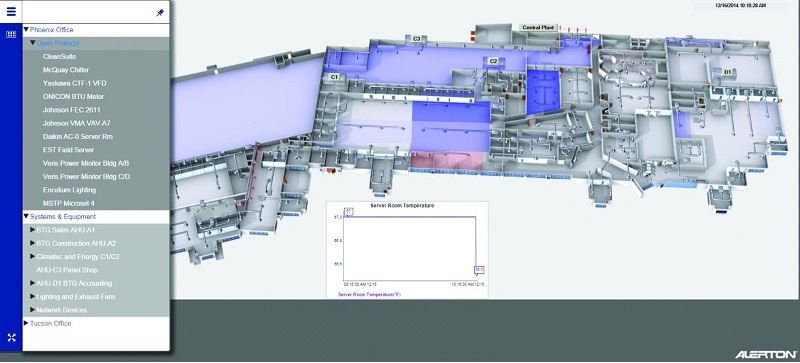Trends in plug load monitoring and management
Kevin Callahan and Kevin Clinger
Alerton
|
July 2016 |
[an error occurred while processing this directive] |
| Plugged In Trends in plug load monitoring and management |
Kevin Callahan and Kevin Clinger Alerton |
| Articles |
| Interviews |
| Releases |
| New Products |
| Reviews |
| [an error occurred while processing this directive] |
| Editorial |
| Events |
| Sponsors |
| Site Search |
| Newsletters |
| [an error occurred while processing this directive] |
| Archives |
| Past Issues |
| Home |
| Editors |
| eDucation |
| [an error occurred while processing this directive] |
| Training |
| Links |
| Software |
| Subscribe |
| [an error occurred while processing this directive] |
Building
owners and operators have two primary reasons to monitor and manage
plug loads – one obvious, and the other less so, but also important.
Simply put, these two reasons are: 1) energy efficiency, and 2)
reliable operations.
Let’s look at each of these, in turn, followed by the current
state-of-the-art in plug load monitoring and management tools.
Energy efficiency
Equipment
plugged into wall outlets represents an ever larger share of energy
consumption in buildings, so naturally building pros are looking there
for energy savings. Plug loads now consume about 15% - 20% of
electricity in offices, and as much as 40% - 60% in some buildings,
reports the New Buildings Institute. A double whammy of trends is
causing this. First, as building envelopes and HVAC systems become more
energy efficient, plug loads naturally account for a larger piece of
the pie. Second is the explosion in the number and types of office
equipment.
Much of plug load consumption is necessary for business operations,
while other draws are wasteful. Think of the difference between
employees using desktop computers during their shifts to complete work
versus leaving monitors on overnight when no one is around. Or, the
employee with a contraband space heater tucked under his desk – not
only drawing power but potentially creating a fire hazard.
With the advent of plug load monitoring and management tools, building
pros have more powerful and sophisticated ways to reduce such phantom
power draws. They no longer have to rely on company memos nagging
employees to shut down equipment at the end of their shifts, or
stickers exhorting them to “turn it off when not in use” plastered on
everything. Instead, equipment can now be turned down or off remotely
and automatically.
Reliable operations
While
reducing electricity waste is a clear benefit of plug load monitoring
and management, an equally beneficial function is ensuring crucial
equipment stays on. So, while facility managers want to make sure an
employee’s desk light isn’t left on all night, they also have an
interest in ensuring that certain equipment stays on. An obvious
example is that power is not cut to mission critical computer servers
or to lab or hospital equipment. A less obvious example is that the
vending machine in the employee break room remains on. While keeping
the Klondike Bars in the office vending machine frozen is not a matter
of life or death, losing power to such a machine can result in costly
waste and a time consuming mess.
Plug load monitoring and management
tools
Today’s
plug load monitoring and management tools help building pros fulfill
both of the above needs. Simple-to-install BACnet-enabled receptacles
interface with building management systems (BMS) to help reduce plug
load costs up to 40%, while ensuring mission critical and other
equipment remains on.
For example, Alerton offers through its dealer network a suite of plug
load tools from Ibis Networks. Such tools provide real-time data on
plug-load energy use, which helps building pros spot excessive power
draws. In the case of the Ibis sockets, as BACnet devices, BMS
operators can easily bring them into Alerton Compass software to be
managed alongside HVAC, lighting and other building systems.

Facility pros can
monitor and manage electrical plugs, along with HVAC, lighting and
other building systems via BMS tools such as Alerton Compass software.
Using these tools, building managers can schedule
selective shutdowns
to individual plugs, while leaving power on for critical equipment in
the same room. For example, shutting down desk lamps in a laboratory
overnight, while retaining power to incubators.
Facility managers also can use plug load monitoring tools to predict
potential equipment failures and take preventative action. A case in
point is a server that starts using higher-than-typical power, which
could indicate the equipment will soon breakdown. By avoiding run to
failure with the server, the facility pros can help avoid costly
disruptions.
About the Authors
Kevin Callahan is a product owner and
evangelist for Alerton, Lynwood, Wash., a Honeywell business
specializing in building management systems. He has 39 years of
experience in the building control technologies field, including
control systems design and commissioning, facilities management and
user training. Callahan can be contacted at kevin.callahan@alerton.com.
Kevin
Clinger is a senior manager of customer marketing for Alerton, with
more than 11 years of experience in various aspects of building
automation systems. He led Alerton’s efforts to bring the Ibis Networks
plug load monitoring solution to Alerton dealers. Clinger can be
contacted at kevin.clinger@alerton.com
[an error occurred while processing this directive]
[Click Banner To Learn More]
[Home Page] [The Automator] [About] [Subscribe ] [Contact Us]